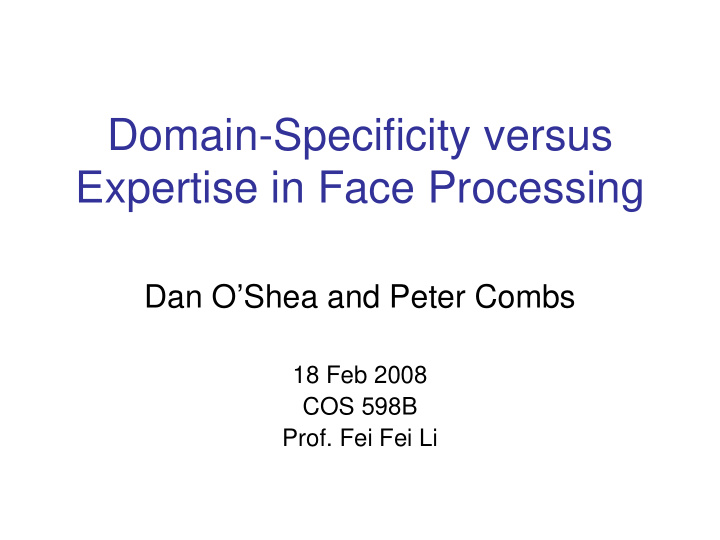



Domain-Specificity versus Expertise in Face Processing Dan O’Shea and Peter Combs 18 Feb 2008 COS 598B Prof. Fei Fei Li
Inferotemporal Cortex and Object Vision Keiji Tanaka Annual Review of Neuroscience, 1996 Objective: Describe the properties of TE cells and the connections leading to and projecting out of TE with the goal of understanding the functional implications of TE’s functional organization in object recognition
Dorsal Visual Pathway • Performs visual stimulus recognition • “What” Pathway
TE Cells Selective for Complex Features Dorsal TE cells selective for moderately complex features, some for combinations of these shapes with color or texture
Orientation and Size Selectivity
Exploring Spatial Locality
TE Columnar Organization
Projections to TE • V4 and TEO selective for complex features � TEO pools project to 3-5 TE columns • TE Pools multiple partial features and RFs � achieves position invariance
Columnar Organization Revisited Overlapping activation spots in optical imaging Continuous Mapping? Substrate for computations?
Alternative Pinwheel Organization
Functional Implications of TE Columns • Distributed representation lends robustness and precision • Hyperacuity by overlapping sensitivities • Binding of multiple coactive columns? – Per-object synchrony – Attentional selection
TE projections to other areas • STPa – social communication • PFC – temporal behavior, decision making • Amygdala – emotional content • Perirhinal cortex – association • IPS – 3d shape for tactile processing
Tanaka Summary • TE achieves position invariance and columnar organization • Two levels of population coding – Combinations of multiple columns – Multiple cells in column with overlapping sensitivity
The Fusiform Face Area: A Module in Human Extrastriate Cortex Specialized for Face Perception Nancy Kanwisher, Josh McDermott, Marvin M. Chun Journal of Neuroscience, 1997. Objective: Demonstrate that the fusiform face area is selectively activated by holistic processing of faces and thus represents a special face-processing vision pathway
Fusiform Face Area
Part I • Comparison: faces vs objects • Purpose: find ROI that responds more strongly to faces than objects • Results: Located FFA in right fusiform gyrus
Faces vs. Objects
Cross-Subject Consistency
Part IIa • Comparison: B&W vs. Scrambled • Purpose: Responding to low-level visual features present only in face stimuli • Results: ROI from Part I responds more strongly to intact faces than scrambled faces (ratio = 3.2)
Part IIb • Comparison: Faces vs. Houses • Purpose: Distinguising between exemplars of single object category? • Results: ROI from Part I responds more strongly to faces than houses (ratio = 6.6)
Part III • Comparison: ¾ faces vs. hands • Purpose: – Do responses generalize to different viewpoints? – Recognition on the basis of internal (versus external) features? – Faces versus body parts? – Effect of attentional load? • Results: Stronger response to faces during passive viewing and 1-back memory task
Kanwisher Conclusion • FFA activation is reliably selective for faces within and across subjects • FFA activation reflects a special processing pathway for holistic face processing • No unified, overarching visual recognition processing scheme
Can generic expertise explain special processing for faces? McKone, Kanwisher, and Duchaine Trends in Cognitive Sciences, 2007. Objective: Address the claims of the expertise hypothesis, show that objects of expertise do not show the same holistic face-like processing patterns, and present a specialized model of face-processing
Inversion Effect
Part-whole Effect
Composite Effect
Prosopagnosia • Prospagnosia and object agnosia are often dissociated • Objects of expertise recognition performance dissociates from face performance as well
Single Unit Recording in Monkeys 97% of cells in middle face patch of macaque monkeys are highly selective for faces
Inverted Faces No holistic processing develops despite training
Parahippocampal Place Area Decoding mental states from brain activity in humans John-Dylan Haynes and Geraint Rees Nature Reviews Neuroscience, 2006.
McKone Conclusion • Many studies have found that objects of expertise do not invoke the same pathways or display the same behaviors as faces • Face processing reflects either an innate template which guides recognition or a different type of expertise with an early critical period
Beyond faces and modularity: the power of an expertise framework Bukach, Gauthier, and Tarr Trends in Cognitive Sciences, 2006. Objective: Discuss the value of an expertise framework independently of the domain-specific vs. domain-general debate concerning face recognition.
Expertise effects outside FFA
Event related potentials: N170
Dual-task Interference
Bukach Conclusion • Expertise framework has implications outside of the FFA debate • Properties and interactions of expertise worth studying
Recommend
More recommend